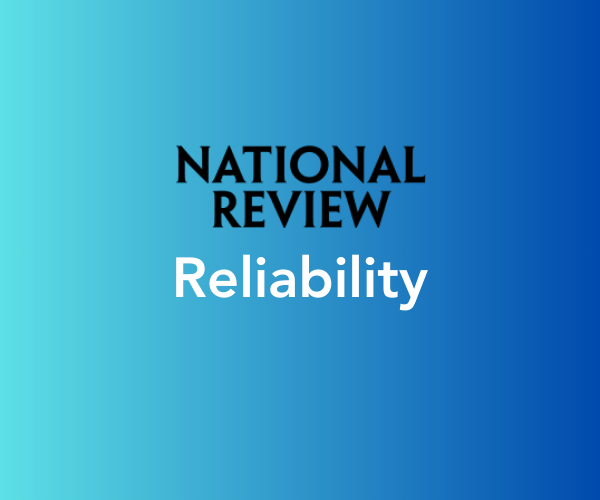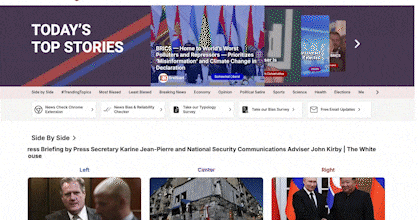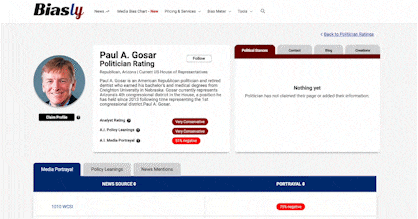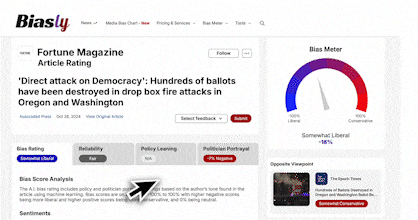
E. Garrett Bewkes IV was appointed The National Review’s publisher in 2018. His goal was to strengthen its influence by modernizing its digital presence, expanding its online reach, and offering the digital membership package NRPlus, all while managing challenges presented by an ever-evolving conservative landscape.
Critics of The National Review often allege that its strong right-wing ideology could result in biased reporting and analyses, thus necessitating critical examination of all its content. Reliability metrics require fact-checking articles for accuracy; selection/omission bias also helps assess whether an outlet presents an even-handed viewpoint by looking at what it includes or excludes in coverage.
Does Reliability Matter?
Reliability, in general, refers to how trustworthy or accurate information, or in this case, a news source is. If we consider this definition, it quickly becomes clear why reliability is important in media sources. If we can’t trust the things we read, then there isn’t much of a point in continuing to consume content from that outlet. So how exactly can we gauge the reliability of a news source?
There are several potential measures of reliability to look out for when trying to determine whether a media source is reliable or not. Red flags for an unreliable article can include the presence of unsubstantiated claims, facts dependent on other unreliable sources, heavy use of opinionated language, and more. Some indicators of a reliable news source, on the other hand, include things like:
- Absence of subjective/opinionated language in articles
- Credible sources cited (e.g., neutral sources, .gov, .edu websites)
- Facts and statistics backed by multiple relevant outside sources
- Use of primary sources when possible (e.g., interviews, quotes)
- Information that remains consistent across news sources
So How Does The National Review Fare in its Reliability?
The political reliability index developed by Biasly objectively assesses news organizations’ accuracy and trustworthiness. The National Review’s overall Reliability Score has been rated as ‘Good’ by Biasly. This rating is a weighted average of two distinct scores: the Fact Analysis Score and the Source Analysis Score, each evaluating separate components of The National Review’s Reliability. When computing the Average Reliability of the article the Fact Analysis score is more heavily weighted. These ratings are as follows in the next two paragraphs:
The National Review’s Fact Analysis Score is ‘Good,’ which suggests readers can trust most of The National Review’s content online. The Fact Analysis score focuses more on the accuracy of claims, facts, and sources presented in the article and any hints of selection and omission bias, which we will discuss further in the article.
The National Review’s Source Analysis Score is ‘Poor,’ which suggests readers can trust few of the sources, links, and quotes provided by the news source. This score, which is based on A.I., focuses on assessing the quality of sources and quotes used including their number, lengths, uniqueness, and diversity.
However, since these scores are based on percentages and averages, individual articles could be more or less trustworthy depending on the context, author, and other factors. Our findings show that The National Review’s reliability is mostly but not all factual because they have retracted several stories in the past or had pieces that were not factual.
Let us analyze the supporting data for The National Review’s rankings and discuss what to watch out for while searching for trustworthy news sources.
National Review Accuracy and Reliability
The credibility of news organizations can be influenced significantly by political bias. With a deluge of available information channels, from traditional media to blogs and social media posts, understanding the key factors determining a news source’s trustworthiness can be instrumental in making informed decisions. The following table provides a comprehensive breakdown of the essential considerations and measures to gauge the reliability of a news source:
| Factor | Description | Reliability Measures |
| Source Credibility | The reputation and authority of the news source | History of accurate reporting, recognized awards (e.g., Pulitzer), and expert endorsements. |
| Authorship | Who wrote or produced the news content? | Verified credentials, record of accurate reporting, transparent biography |
| Citation of Sources | How well the news story cites its sources of information
| Use of primary sources, direct quotations, and explicit reference links |
| Bias and Objectivity | The presence or absence of apparent bias in presenting facts
| Balanced representation of perspectives, lack of emotive language, clear fact-checking |
| Timeliness | The currency of the news story, as it ages, may not reflect current realities. | Date of publication, updates as new facts emerge
|
| Consistency with Other Reports | Comparing the news story with other reputable sources to ensure consistency | Corroboration by other reputable outlets, lack of contradictions between sources |
| Transparency | Openness about the process of news collection, verification, and any corrections made | Published methodology, corrections or retractions made openly, disclosure of conflicts |
| Editorial Policies | The internal guidelines and policies that the news organization follows. | Peer review policies, use of fact-checkers, standards for sources |
| Ownership and Funding | Who owns the news source, what are their potential motivations, and who are their advertisers? | Disclosure of ownership, transparent advertising policies, lack of hidden sponsors |
Specifically, The National Review is sometimes guilty of putting a conservative agenda before factual reporting. Nonetheless, we can thoroughly examine their news articles to determine whether this claim is valid. As we evaluate the accuracy and validity of the pieces, we will look for any potential signs of selection and omission bias.
Selection bias is when stories and facts are selected or deselected, often on ideological grounds, to create a narrative in support of the news sources’ ideology. Omission bias, on the other hand, is when different opinions and political views surrounding a situation are left out so that the reader is only exposed to the ideological perspective supported by the author. It’s important to keep in mind these two types of biases when trying to assess an article’s level of accuracy.
Biasly employs a percentage system to assess accuracy levels, ranging from one (representing lowest accuracy) to 100 (representing maximum accuracy). Evaluation involves analyzing a claim’s credibility, evidence, and reliable internal sources within an organization. Biasly provides detailed information on its website for reliable and precise news ratings from The National Review.
“Trump Blames Biden’s Weakness for Emboldening Russia, Sounds Alarm on Domestic Decline,” an article by Caroline Downey, covers a speech by former President Donald Trump at CPAC and focuses heavily on conveying Trump’s views and statements verbatim, with minimal additional context or counterpoints. Below is a summary of our thoughts and analysis of this article.
Selection and Omission Bias:
1. Narrative Creation – The article’s framing supports Trump’s perspective. The selected quotes paint a picture of the Biden administration’s failures in domestic and foreign matters. According to Trump:
“Joe Biden has turned calm into chaos, competence into incompetence, stability into anarchy, and security into catastrophe. The Russian attack on Ukraine is appalling. It is an outrage and catastrophe that should never have been allowed to occur. It never would have occurred.”
2. Emphasis on Trump’s Achievements – The article presents Trump’s claims about his successes without offering a counter-narrative or clarification:
“Touting his administration’s triumphs on energy independence via the Keystone XL pipeline, a secure border, and a presidential term without a single armed conflict overseas, Trump said Biden reversed all the progress that he made.”
Quality of Sources and Facts Used:
1. Claims Without Context – The article reports controversial statements by Trump, such as claims about the 2020 election getting rigged, without referencing the many court decisions and investigations that found no evidence of widespread fraud:
“Trump claimed that avoiding the mayhem in Europe would have been possible if someone hadn’t rigged the 2020 election, a theory he has upheld since his loss.”
2. Lack of Counterarguments – Throughout the article, the criticisms that Trump directs at the Biden administration lack counterarguments or perspectives that provide a more balanced view. For example, the article doesn’t discuss Biden’s reasons for withdrawing from Afghanistan or his administration’s measures to address domestic issues.
3. Absence of External Views – The article presents no external opinions from experts, political figures, or the public to contrast Trump’s claims. This lack of context leaves readers without a broader understanding of the discussed issues.
4. Unaddressed Accusations – The article mentions accusations against Trump about his relationship with Putin. Still, it does not delve into the details or context of those accusations.
“While Trump insisted it’s “a good thing” to have a working relationship with dictators, he got accused of being a crony and too sympathetic to Putin while in office.”
Considering the points above, it’s evident why Biasly would assign the article a bias rating of Moderately Conservative. The content, while factually reporting Trump’s speech, omits necessary context and counterarguments that would provide a more well-rounded understanding. Additionally, the policy leaning score was Very Conservative, suggesting that the writer expresses sentiments that favor specific political policies.
Although Biasly does not have an official Reliability score for this piece, assigning it a rating of “N/A,” readers must still approach such articles critically, acknowledging potential biases and seeking diverse sources to ensure a holistic understanding of the issues.
Analysis of Reliability in National Review Opinion Pieces
It is essential to exercise caution to avoid biases from overshadowing objective reporting in mainstream news. Although op-eds will inevitably contain strong preferences, this can positively or negatively affect their credibility. Nevertheless, opinion pieces can still provide a unique opportunity for new insights into various political perspectives.
Regarding opinion pieces specifically, The National Review website has faced controversy for publishing misleading information. For example, on February 7, 2017, Julie Kelly wrote an op-ed entitled “A Top Climate Scientist Blows the Whistle on Shoddy Climate Science.” The article claims Dr. John Bates, a former top NOAA scientist, exposed misconduct in a global warming report released before the 2015 U.N. Climate Change Conference.
Dr. Bates accused Tom Karl, the lead author of a study on global warming, of using unverified data. The study adjusted sea temperatures for warmer ship data, “ignored satellite data,” and encountered computer glitches due to unarchived files – leading to the NOAA’s plan to reverse flaws:
“They had good data from buoys,” he told the Daily Mail. “And they threw it out and ‘corrected’ it by using the bad data from ships [a natural warming source]. You never change good data to agree with the bad, but that’s what they did so as to make it look as if the sea was warmer.”
This quote highlights an essential facet of the scientific process: the criticality of data integrity and the potential dangers of selective data usage or manipulation. It suggests that the NOAA study cherry-picked data aligned with a preconceived conclusion or narrative rather than allowing the data to dictate the decision. In doing so, not only does the research potentially misinform the public, but it also erodes trust in the scientific process.
The choice between buoy data (presumed to be “good” by Bates) and ship data (which Bates implies is skewed due to the ships being a “natural warming source”) represents a more profound ethical and methodological debate about the responsibility scientists have in presenting accurate and unbiased findings. In an age where misinformation can rapidly spread, the implications of such choices are far-reaching. Suppose scientists or organizations manipulate or selectively present data to fit a particular agenda. In that case, they risk undermining the public’s faith in research and empirical evidence, which can have long-term implications for policymaking, public trust, and the broader acceptance of scientific consensus.
The quote above also underscores a pivotal dilemma in scientific research: the tension between the search for “truth” (or as close to it as we can get) and external pressures (whether political, economic, or social). The phrase “to make it look as if the sea was warmer” suggests intent: an intent to cater to these external pressures rather than adhere strictly to what the data means. In an era where climate change is both a pressing global issue and a contentious political topic, this tension becomes even more pronounced and its consequences even more significant.
Regarding the computer issues:
“Bates said that the computer used to process the data ‘suffered a complete failure’ and that none of the data had been archived or made available as required by NOAA rules, which means that Karl’s paper cannot be replicated or independently verified.”
According to Kelly, Science magazine stands by its rigorous peer review, and Rep. Lamar Smith wants further investigation. The author also asserts that Bates’ revelations may help promote greater transparency within national scientific agencies.
On the other hand, while Bates claims in an interview that he had concerns about data handling and transparency, a contradictory article from A.P. News states that there was “no data tampering, no data changing, nothing malicious.” Bates’ concerns were primarily about the protocol: “It’s really a story of not disclosing what you did.” Nevertheless, independent research from the University of California, Berkeley, confirmed the findings of the 2015 study. Lead author Zeke Hausfather emphasized the study’s accuracy by saying, “Not using their data we get the exact same results, both for the ocean record and for the land.”
According to E&E News, Bates clarified,
“The issue here is not an issue of tampering with data, but rather really of timing of a release of a paper that had not properly disclosed everything it was.”
In other words, the NOAA needed to follow agency protocol and not rush their research to publication. However, the validity of the data remained undisputed. Bates specifically stated that the data was “experimental” and that the publishing safeguards in place help ensure the integrity of federal research.
Integrity in journalism requires striking a balance between subjective opinions and objective reporting. Op-eds provide various viewpoints. Yet, critical engagement with sources like The National Review can be especially crucial due to potential biases. The coverage of the data manipulation scandal emphasizes the journalistic need for The National Review to maintain accountability and conduct proper fact-checking procedures.
Quality of the Sources and Facts Used
This analysis will assess the National Review’s ability to use precise reporting methods and substantial references. The first piece we will tackle is “Kids in the Crosshairs of the COVID-Vaccine Battles,” by Michael Brendan Dougherty. The article explores the debate over vaccinating children against COVID. Dougherty only uses two direct, medium-length quotes and paraphrases health officials and parents who acknowledged their children were more in danger from the vaccine than from getting COVID. The author’s eight sources for the article are as follows:
- A piece from The New York Times claiming that unvaccinated kids are less likely to get COVID than vaccinated elderly people
- An Intelligencer article calling for safety protocols to acknowledge that children are not as susceptible to COVID as adults are
- An HBO documentary detailing the many injustices of Big Pharma
- A Guardian article asserting that teenage boys are more likely to get vaccine-induced myocarditis than end up hospitalized with COVID
- A piece from Western Standard detailing a misleading case where a terminally ill 14-year-old boy was said to have died from COVID when he died from brain cancer
- A CDC COVID data tracker measuring reported cases based on race/ethnicity
- A USA Today article exploring child COVID cases, hospitalizations, and deaths
- Another New York Times article writing about the expansion of Pfizer-BioNTech and Moderna vaccine trials to five-11-year-olds
Dougherty emphasizes the low risk of serious illness in kids and the debate around mandated vaccines. He also discusses various attitudes among parents; some enthusiastically embrace vaccination while others raise safety issues and point to statistics demonstrating children are less prone to COVID. The article makes it a point to highlight the stark differences between the U.S. and European approaches regarding child vaccinations, suggesting that U.S. policy should take a more liberal stance: “And, unsurprisingly, we are the country moving the fastest and the most anxiously to green-light juvenile vaccines. European countries have been taking it more slowly. The U.K. paused a vaccine-approval process and then picked it up again, as the virus spread in schools and some parents demanded vaccines. But the vaccine was voluntary for families.” Overall, this piece displays an array of perspectives through its diverse use of sources. However, their quality varies; non-political entities like the CDC and mainstream outlets on the opposite side of the aisle of The National Review, like The New York Times, The Guardian, and USA Today, lend credibility. At the same time, lesser-known publications like Western Standard and The Intelligencer may sow doubt in reliability.
Diversity in sourcing isn’t merely about quantity; it also ensures that the writer incorporates a range of perspectives to provide holistic and balanced accounts. As readers become more aware of media biases, an imbalance in sourcing might lead to reduced trust in the article, especially among those who prioritize balanced reporting. Regardless of an outlet’s perceived bias, it’s crucial to approach each piece critically, considering the information provided and its source.
Still, the article features many well-documented facts in its analysis, such as children’s decreased susceptibility to COVID-19 and potential vaccine side effects. That said, Dougherty’s myocarditis claim from the Guardian article is subject to intense debate, considering scientific experts have proven that although teenagers are most susceptible to myocarditis, the risk of contracting the disease from the vaccine is far less likely than acquiring it from COVID. Nowhere in Dougherty’s article is this fact acknowledged, indicating that it may contain selection bias.
Selection and Omission Bias
The article from the previous section, “A Top Climate Scientist Blows the Whistle on Shoddy Climate Science,” also demonstrated selection/omission bias. It is a source of misleading information that echoed claims of the NOAA publishing a faulty climate change study with fabricated findings. While data manipulation warrants serious investigation, readers must approach allegations like these carefully and strategically to avoid spreading misinformation. The complexity of climate data analysis and ongoing scientific debates render it crucial to rely on peer-reviewed research and expert consensus to comprehensively understand critical issues relating to climate change.
In the previously discussed article, “Kids in the Crosshairs of the COVID-Vaccine Battles,” Michael Dougherty explores the complex debate about vaccinating against COVID-19. As we dive into an in-depth analysis, we’ll examine the accuracy of the article and any potential biases. To investigate Dougherty’s sources further, we will also consider selection/omission bias and the author’s level of one-sidedness.
The article raises concerns about selection bias by primarily citing sources that support the author’s skepticism toward vaccinating kids. There is a noticeable omission of opinions and statements that would provide contrary arguments highlighting the benefits of vaccines for children. This gap could lead to a distorted and incomplete portrayal. Despite still referencing the claims of pro-vaxxers and not excluding them entirely, Dougherty does not directly quote them. In contrast, he routinely cites anti-vax arguments and uses two direct quotes to strengthen them.
Regardless of an outlet’s perceived bias, it’s crucial to approach each piece critically, considering the information provided and its source. While valid for some readers and a good starting point, this approach could steer the discussion away from comprehensive public health considerations. Furthermore, it undermines a more holistic assessment of the topic by not mentioning that unvaccinated kids could infect their older parents or guardians, who are more vulnerable to COVID. This instance of selection bias raises concerns about partisanship and incomplete reporting.
Considering all this, news and opinion articles often raise issues surrounding accuracy, source reliability, content curation, and biases that ignore crucial context. Some partisan pieces we’ve read ignore contextual details or other viewpoints that might challenge their position. Additionally, The National Review, a media institution known for its conservative views, is naturally interested in appealing to its readership by catering to right-leaning ideology. That said, staying up-to-date with the most recent, meticulously verified news reports is essential to provide well-informed opinions.
So, Is The National Review Reliable?
The National Review is well-known for its high-quality analysis and commentary on cultural and political issues, often through a conservative lens. That being the case, readers should still evaluate its reporting standards carefully and be aware of reliability issues within the organization. To ensure a well-rounded and comprehensive understanding of this practice, you can use Biasly’s News Bias Checker to uncover problems with reliability and help you find the most credible news possible.

























